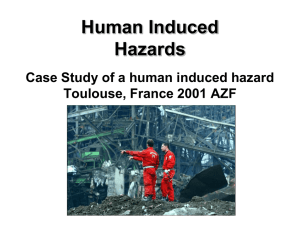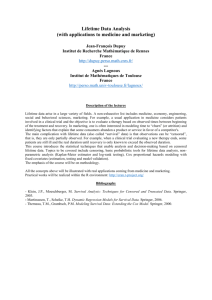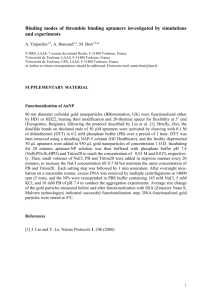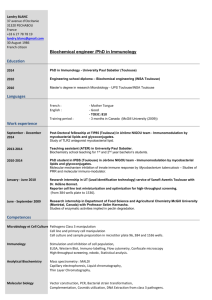AZF TOULOUSE TECHNOLOGICAL DISASTER – risk assessment
advertisement
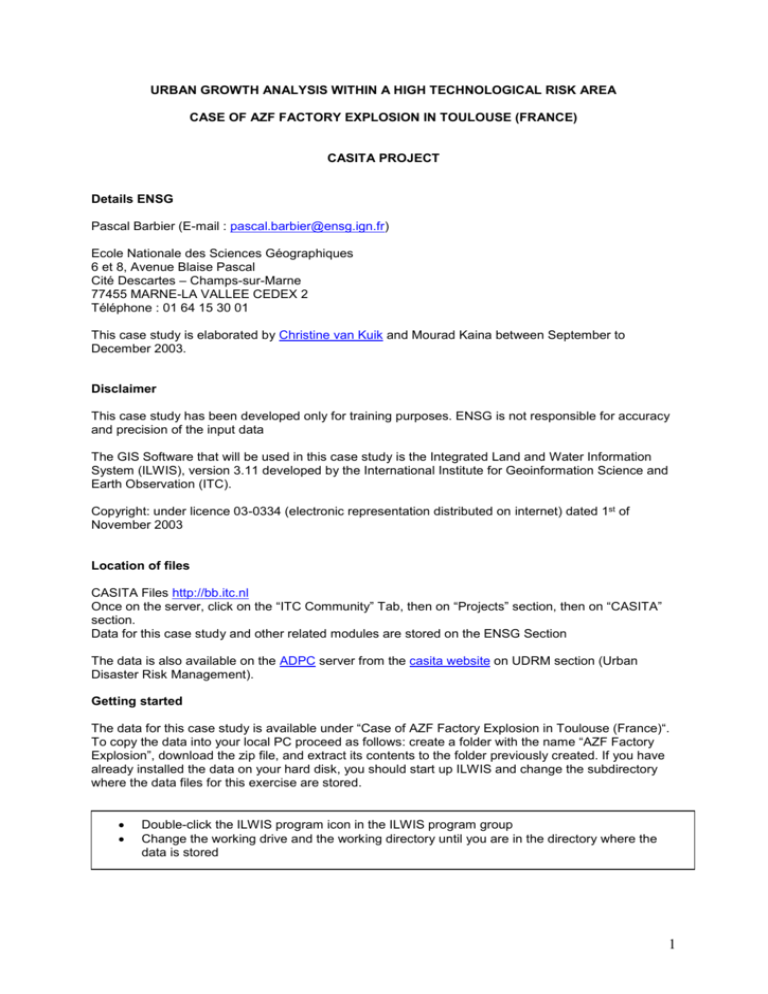
URBAN GROWTH ANALYSIS WITHIN A HIGH TECHNOLOGICAL RISK AREA CASE OF AZF FACTORY EXPLOSION IN TOULOUSE (FRANCE) CASITA PROJECT Details ENSG Pascal Barbier (E-mail : pascal.barbier@ensg.ign.fr) Ecole Nationale des Sciences Géographiques 6 et 8, Avenue Blaise Pascal Cité Descartes – Champs-sur-Marne 77455 MARNE-LA VALLEE CEDEX 2 Téléphone : 01 64 15 30 01 This case study is elaborated by Christine van Kuik and Mourad Kaina between September to December 2003. Disclaimer This case study has been developed only for training purposes. ENSG is not responsible for accuracy and precision of the input data The GIS Software that will be used in this case study is the Integrated Land and Water Information System (ILWIS), version 3.11 developed by the International Institute for Geoinformation Science and Earth Observation (ITC). Copyright: under licence 03-0334 (electronic representation distributed on internet) dated 1st of November 2003 Location of files CASITA Files http://bb.itc.nl Once on the server, click on the “ITC Community” Tab, then on “Projects” section, then on “CASITA” section. Data for this case study and other related modules are stored on the ENSG Section The data is also available on the ADPC server from the casita website on UDRM section (Urban Disaster Risk Management). Getting started The data for this case study is available under “Case of AZF Factory Explosion in Toulouse (France)“. To copy the data into your local PC proceed as follows: create a folder with the name “AZF Factory Explosion”, download the zip file, and extract its contents to the folder previously created. If you have already installed the data on your hard disk, you should start up ILWIS and change the subdirectory where the data files for this exercise are stored. Double-click the ILWIS program icon in the ILWIS program group Change the working drive and the working directory until you are in the directory where the data is stored 1 CASITA MADRIS Modules covering subjects of case study ( Accessible on 1 Explosion theory (Module I-1-E Understanding the phenomenon of VCE) Modules within II Accidental Risks linked to fixed installations Introduction Within the framework of the CASITA project, this case study has been developed related with urban development issues in areas of potential high technological risks. As an example, the AZF factory explosion in Toulouse on the 21st of September has been chosen, in which the urban development during the last 50 years has been looked at using a GIS analysis (section 5). Furthermore general background information is provided to have an umbrella view of the urban planning problem and not only the know-how of the technical ILWIS handouts. This information concerns the event and impact of the disaster (section 3), the regulation with respect to dangerous factories in France (section 4), the lessons learned and recommendations to prevent future disasters (section 6). Fig 1 2 AZF Factory Objectives of case study The objective of the study is the analysis of urban growth development within potentially danger zones. In France these zones have been assigned by legislation as restricted urban areas for expansion due to the existence of high risks for population and infrastructure. With the use of a GIS analysis (in this case ILWIS 3.1, see section 5) one can show the actual growth within these zones and hence show the success or failure of legislation implementation as one of the problems and therefore challenges of disaster mitigation. 2 3 Description of AZF Toulouse Disaster On 21 September 2001 a fertiliser factory containing ammonium nitrate storage facilities exploded. The factory, part of the oil giant Total, which employed 470 persons, was located 3 km from the centre of Toulouse on an island of the Garonne River surrounded by an (urban) environment, see figure 1, 2 and 3. Fig 2 Aerial photograph of AZF location Toulouse fig 3 AZF location 3 km of centre of The consequences of the AZF explosion were severe (equivalent to an earthquake intensity of 3.4 on the Richter scale). The explosion produced a crater measuring about forty meters in diameter and 7 m in depth related to the natural ground. The most important consequences are listed below: 22 people were killed on the factory site and 8 persons outside. In total 2500 persons were injured; Various structures were distorted within a radius of 400 to 700 m. Buildings were damaged within a radius of 700 to 1500 m and many windows broken even at a larger distance. In total about 30,000 buildings were touched of which 10,000 heavily damaged including schools, universities and a hospital. Transportation facilities and electrical power lines and telephone communication were also disrupted. The financial consequences of the technological disaster amounts to 2.5 milliard euros. 4 High risk zone regulations in France 4.1 General In France (and in Europe in general), regulations have been established to deal with urban growth in areas where potential technical risks are high for dangerous factories, the so-called SEVESO factories. In figure 4, the locations of these Seveso factories are shown in France. 3 Fig 4 Locations of SEVESO factories in France The SEVESO I legislation established in 1982, called for hazard studies with respect to installations that incorporate the risk of major accidents. It also requires regular inspections, and public information about what to do in the event of accidents. The SEVESO II legislation established in 1996 requires furthermore the set up of safety management systems and a periodic re-examination of the existing hazard studies every 5 years. It also requires a set up of emergency plans and urban development plans, in which serious consequences of certain accidents beyond the confines of industrial sites are investigated. 4.2 Urban zone planning regulation in Toulouse Based on the SEVESO I legislation, in 1987 for the AZF factory together with nearby located factories, a whole series of safety studies were carried out and hazard criteria and accident scenarios identified. In 1988 urban development control procedures were also set up in the form of a General Interest Project (PIG) establishing a perimeter inside which urban development is strictly regulated shown as shown in the inner-line in figure 5 and procedures for protecting inhabitants by means of a Special Intervention Plan (PPI), as shown in the outer-line in figure 5. In order to establish a PIG internal zone perimeter, a criterion of toxicity has been used, for which irreversible effects begin to appear (the limit where people begin to experience a general feeling of being unwell). In the case of AZF Toulouse this zone is defined by an interpolation of circles based on the location of the different factories and their production and stock with a radius of 900 m, 894 m and 600 m. This zone covers about 5 km 2. 4 The PPI (external zone) was created and put in place at the same time as the PIG. The PPI is based on the following statement: ‘it is not possible to completely rule out an accident, however improbable such an event may be. Because of the dramatic consequences which an accident would produce in such a sensitive industry, it is advisable to prepare for such a hypothetical accident’ which creates the need for factories to have Internal Operation Plans. The PPI is put in place to ensure that or the triggering of the alarm, the traffic and the emergency services are properly organized; in which the possibility of a substantial number of seriously injured people is included. In the case of AZF Toulouse the radius for the PPI are of 2150 m, 1600 m, 1500 m. The zone covers a total of 15 km 2. Fig 5 PPI (exterior zone) and PIG (interior zone) In 2001, at the time of the AZF disaster, within the PIG zone, there were over 1000 people (inhabitants and workers), and 16,000 within the PPI zone. For the PPI zone in the past no urban growth restrictions were defined, and only alerting operations were required. For the PIG zone all new construction was prohibited from 1988 onwards. 5 GIS analysis of urban growth in defined zones Since the middle of the last century, urban development around the chemical factories has grown considerably. At that time, there was scarcely anything in the vicinity of these sites. Since the ‘50s, urban development has continued around the perimeter of the AZF factory. 5.1 Received data The raw data, presented below is made available by different institutes in France. The data were simplified for practical reasons so that it could be used for the ILWIS program. 5.2 Orto-photo Toulouse of 1997 by IGN (National Geographic Institute of France) (raster map) Base map of buildings for different years including theoretical estimations of actual population living in these area based on factors such as work/home mobility, etc. and the number of livings for each building in 1997 calculated by interpolation elaborated by IGN based on the building surface and its height with respect to year 1997 (vector map) The zone limitations defined by SEVESO regulations (polygon map) Landsat image downloaded from internet to serve as a base map Urban Growth Analysis Method The flowchart shows the different steps of the analysis. The GIS-ILWIS analysis has been carried out to extract the number of livings and population within the PPI and PIG limitation zones for the years 1946, 1962, 1970, 1979, 1988 and 1997 based on the overlaying of the different maps and the superposition of data. Afterwards EXCEL has been used to elaborate graphs to analyse the results, in which the development of livings is presented against the timescale, see section 5.4. 5.3 Input data for the Analysis The input data for this case study is available under blackboard “case study on AZF Toulouse, France” directory CASITA course modules – ENSG’s materials. 5 1 Toulouse georeference 2 3 4 5 Toulouse1997 Exterior_limit Interior_limit Building 1946 6 7 8 9 10 Building 1962 Building 1970 Building 1979 Building 1988 Building 1997 Fig 6 5.4 Georefence tie points to pinpoint the coordinates of a raster map with a (x, y) coordinate system Raster map of area around AZF factory (picture elements) Polygon map (vector map) containing the limit of the PPI zone Polygon map (vector map) containing the limit of the PIG zone Point map containing points; in this case the points are represented by the buildings around AZF factory in year 1946 Same as for the buildings in year 1962 Same as for the buildings in year 1970 Same as for the buildings in year 1979 Same as for the buildings in year 1988 Same as for the buildings in year 1997 Flow chart for the case study procedures Procedures (ILWIS AND EXCEL) Below procedures are presented to analyse the vulnerability with respect to the AZF factory explosion. The procedures comprise: how to import raw data, how to georeference imported tif maps, how to rasterize vector maps and how to cross raster maps. EXCEL has only been used to show the results graphically (The way to produce these graphs are not within the framework of this case study). Procedure 1: How to import base data (such as tif/dxf files) in ILWIS Click on File – Import – Map (look for *.tif extension file) – import file name Toulouse1997.tif. After importing, two new files are created in your directory: a raster map and an auxiliary file with the name “Toulouse1997”. Procedure 2: How to georeference a data map Click on file – create – georeference Name the georeference file “georeference Toulouse new” – use the georef tiepoints – use coordinate system “unknown” – using as background map the “Toulouse 1997” raster map. The georeference editor is open to edit points. 6 The map should be put into georeference (x, y) coordinates, which is done by superposing minimal five points of the Toulouse1997 map with known (x, y) coordinates. For this procedure the five (x,y) coordinates are shown below, which are also indicated on the Toulouse1997.tif with a number for each point. No. 1 2 3 4 5 X-coordinate 527006 528137 524299 524262 524064 Y-coordinate 1842790 1839410 1837940 1842070 1839800 On the Toulouse 1997 raster map you click on the first number (in red), of the 5 points and a table will come up where you enter the (x, y) coordinate of the point, and so on for all 5 points. Use the zoom function in order to have an accurate position for the (x, y) coordinates. After inserting 3 points the editor calculates the other 2 points by interpolation. It is best however to continue inserting the (x, y) coordinates. Then exit the georeference editor. A georeference is made and on the right corner of the ILWIS programme the (x, y) coordinates are shown. Go to file and exit the georeference editor (click on file – exit editor). A file “georeference Toulouse new ” has been made and in the left bottom the (x,y) coordinates are shown on the map. For the next procedures use the “georeference Toulouse” in stead of your “georeference Toulouse new”, because this georeference has been used for the next calculations. Procedure 3: How to connect an attribute file to a point map in order to have more data connected to do the vulnerability analysis. Open a point map file (for example “building 1946”) _ click on properties and a window will be popup, in which you can choose to insert an attribute table. Choose attribute table “building 1946 attribute” and verify by clicking on the file – open pixel information in order to look at the information connected to the points (buildings) of the map. The last two information details are important (PSDC99_BAT = number of population and NLOG99_BAT=number of livings) See the table below as an example of the pixel information one should get Coordinate building 1988.mpp ID Type Toponyme Z_Min Z_Max TypeEncein NatureEnce ToponymeEn Hauteur NbEtages SurfDev PSDC99_BAT NLOG99_BAT (528838.22,1842298.83) nr 7022 7230 Bâtiment quelconque 157.10 159.50 13.30000000000 5.00000000000 0.00014100000 5.78074900000 2.51336900000 Procedure 4: Crossing of rastermaps In order to calculate the number of livings and the population within the exterior PPI and interior PIG the point map for example “building 1946” which represent the buildings and the polygon map “interior_limit”, which represent the zone limits should be crossed (see figure 7 an example of the buildings of 1946 within the interior and exterior limit). In ILWIS however it is not possible to cross point maps or polygon maps; only raster maps can be crossed. Therefore one should make raster maps from the point and polygon maps as follows: 7 Click on Operations – Rasterise – Point to Raster respectively Polygon to Raster – a window will popup where you should enter the name of the point map to be transformed (for example “building 1946”, fill in as pointsize 1, the name of the output file (same name=”building 1946”) and the georeference, which we created in procedure 2 “georeference Toulouse” Hereafter other raster maps can be made based on this original raster map “building 1946” one for different elements of the attribute table as follow: Click on Operations - Raster operations – Attribute map – a window will popup where you should enter the name of the original raster map, the table as the attribute table to pick out a column of the attribute table, the selected column itself (PSDC99_BAT, NLOG99_BAT), and the output raster map (for example “building 1946 psdc99_BAT” or “building 1946 nlog99_BAT”). Then crossing of the raster maps is done by clicking on Operations – Raster operations – Cross. For the first map insert one of the building raster map for example “building 1946 psdc99_BAT” for the second one the “exterior_limit” raster map and name the output table name “building 1946 psdc99_BAT exterior”. The table should come up with the number Npix (number of building surface within the limit) and the number of livings (nlog) respectively the number of population (psdc). You can also name an output map to show graphical results. For the year 1946 the above crossing procedure has already been carried out and the files are already presented. To do the same for the other years will give finally the results with respect to the number of livings and population within the interior and exterior zone for all years. . The graphical results are presented in section 5.5. Fig 7 Plot of buildings and limit zones for year 1946 1946 1962 1970 1979 1988 1997 No. Buildings exterior 1365 1842 2162 2500 2741 2967 No. Buildings interior 559 604 681 733 741 782 Nlog exterior 3729 5340 6 556 7 678 8 331 9 048 Nlog interior 201 240 264 283 276 301 Psdc exterior 6 997 10 258 13 067 15 068 16 453 17 900 Psdc interior 340 420 461 491 485 528 8 Procedure 5: How to display different layers and print maps Open the raster map “Toulouse1997” and create new layers (click on layers – add layers) choosing the polygon map “exterior_limit”, “interior-limit” and the point map “building 1946”. Print the map by clicking on file – create layout – type for scale 35,000 and save as view case 1946 AZF Toulouse. Hereafter go within the layout editor clicking file – export to bitmap and name it the same. (extension .bmp). The plot is shown in figure 7. 5.5 Results of urban growth GIS analysis The first excel graph shows the urban growth of the ratio of livings within the PPI zone (exterior zone) and the PIG zone (interior zone) based on the number of livings in 1946. In the interior zone between 1980 and 1990 the number of livings slightly reduces (see also the absolute numbers in the graph). After 1990 however the slope of the curve equals the slope before 1980. In the exterior zone the number of livings increases during the period 1946 to 1997, with a higher rate compared to the increase in the interior zone. URBAN GROWTH (RATIO NUMBER OF LIVINGS) WITHIN THE INTERIOR (PIG) AND EXTERIOR (PPI) ZONE 3,00 9 048 2,50 8 331 Ratio number of livings 7 678 2,00 6 556 5 340 1,50 301 283 276 264 3 729 240 1,00 201 0,50 0,00 1940 1950 1960 exterior zone 1970 1980 1990 2000 year interior zone The second graph shows the urban growth of ratio of population within the PPI zone (exterior zone) and the PIG zone (interior zone). For the calculation of the population also the population in mobile or no homes, the persons in military centers, internates, hospitals has been taken into account. Based on an overall relation between the number of livings and the population the graphs and hence results look alike. In the interior zone between 1980 and 1990 the number of population slightly reduces. After 1990 however the slope of the curve equals the slope before 1980. In the exterior zone the number of livings increases during the period with a higher rate compared to the interior zone. 9 URBAN GROWTH (RATIO NUMBER OF POPULATIONS) WITHIN THE INTERIOR (PIG) AND EXTERIOR (PPI) ZONE 3,00 17 900 2,50 16 453 Ratio number of population 15 068 2,00 13 067 10 258 1,50 528 491 485 461 6 997 420 1,00 340 0,50 0,00 1940 1950 1960 1970 exterior zone 6 1980 1990 2000 year interior zone Conclusions As shown in the GIS analysis, construction has been taken place within the PIG internal zone, although legislation should have forbidden construction of buildings after 1988. There can be several reasons for the neglected implementation of these regulations. In a complex environment, like an urban area, many different actors are involved, with different priorities and goals (such as national, local policy makers, enterprises, civil society, etc). All these different groups do have an important role in the government decisions. Furthermore the legislation was based on old standards, which were renewed but not put into force by the urban government. Some general recommendations, that can be made based on this case: New measures have to be put in place, regarding the implementation of urban growth regulations and the set up of new zone areas according to new standards, which should go back to 1990 and give them a statutory form. These measures should be based on a clear statement of accepted residual risks defined by all actors involved (the State, the Ministries of the Environment, Regional Development, Industry, Equipment, Transport and Housing) in which also the public should be informed to increase their awareness and resilience. Hazard studies have to be revised in light of the existing situation. Most dangerous factories, should be given priority, based on their stored products, size of the exposed area and number of population affected. In some cases relevant authorities need to ask themselves whether the activity should be allowed to go on - with steps being taken to make it safer, or whether the activity needs to be brought to an end. Also new urban and industrial projects have to be clearly assessed in future, in accordance with up to date regulations. It must be stressed that these kinds of measures can only be successfully implemented if the local government has the power to act and is not limited due to other regulations put in place. Based on the AZF Disaster the French Government has put new regulations in place from July 2003. These regulations concern new measures to improve the efficiency of future construction limitations and to deal with existing dangerous situations of urbanism around SEVESO sites. For more background information please find attached the reference documents and websites. 10 References F. Barthelemy, H. Hornus, J. Roussot. J. Hufschmitt, J. Raffoux, Report of the General Inspectorate for the Environment, Accident on the 21st of September 2001 at a factory belonging to the Grande Paroisse Company in Toulouse, Explosive Inspectorate and INERIS, affair no. IGE/01/034 L’explosion de l’usine AZF de Toulouse 21-09-01, www.ac-toulouse.fr/histgeo/monog/azf/azf.htm Toulouse et suites, Les riques industriels en France. Congrès conjoint des associations CPGSC, CRAIM et DRIE-Montréal 4-5 novembre 2002 INERIS, l’Analyse des Risques Eléments pour la maitrise des risques dans le cadre de l’Etude de Dangers, Mastère « Sécurité Industrielle et Environnement », 15 avril 2002 M. Chrisou, S. Porter, Guidance on land use planning as required by council directive 96/82/EC SEVESO II), 1999, European Commision G. Papdakis, A. Amendola, Guidance on the preparation of a safety report to meet the requirements of council directive 96/82/EC SEVESO II, 1997, European Commission N. Mitchison, S. Porter, Guidelines on a major accident prevention policy and safety management system as required by council directive 96/82/EC SEVESO II), 1999, European Commision Major industrial hazards in Land-Use planning, Workshop on land use planning, 12 to 14 february 2002, Lille, France http://www.mahbsrv.jrc.it/Lille/LUP-agenda.html Websites Major Accident Hazards Bureau (joint Research Centre EU) DRIRE INERIS http://mahbsrv.jrc.it/ http://www.drire.gouv.fr/ http://www.ineris.fr BARPI (Bureau d’Analyse des Risques et Pollution Industrielles http://aria.environnement.gouv.fr/index2.html Risques technologiques, Ministère del’écologie et du développement durable (department for the prevention of pollution and risks), France http://www.environnement.gouv.fr/actua/cominfos/dosdir/DIRPPR/industriel/principes-generaux.htm http://www.environnement.gouv.fr/actua/cominfos/dosdir/DIRPPR/bilan_azf/ Environment and Human Settlements Division of the United Nations http://www.unece.org/env/teia/welcome.html European Environment Agency http://reports.eea.eu.int/ 11
